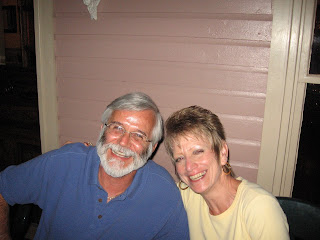 Devils Tower
Devils Tower Picture of the events in the Indian legend.
Picture of the events in the Indian legend. Indian Pray Bundle
Indian Pray Bundle Prairie Dog Town
Prairie Dog Town 240 Ton Truck
240 Ton Truck Trucks at Work
Trucks at Work Digging a 100 foot seam of coal.
Digging a 100 foot seam of coal. Train loader
Train loaderWe are in Gillette, Wyoming at the Cam-Plex Event Center for eleven days to attend the Escapees RV Club Escapade. On Thursday we went on a HOP (Head Out Program) to Devils Tower National Monument and the Eagle Butte coal mine. The tower, which was the nations first national monument, is in the Black Hills of Wyoming an area that is very sacred to the Indians. The tower was formed when molten magma forced its way up through the sedimentary rock and cooled underground. Over a period of 60 million years the Belle Fourche River eroded the sedimentary rock leaving the tower that rises 867 feet from the base and 1267 feet above the river. The Indian legend says the tower was formed when a boy turned into a bear and went after his seven sisters. The sisters ran to a tree stump, which rose into the air to protect them from the bear, and then turned into the tower. The lines on the tower were caused by the bear's claws as he tried to climb it and the sisters became the stars of the Big Dipper. Several thousand people a year now climb the tower but no one was climbing at the time we were there because the Indians consider June to be the most sacred month. Within the monument is a large black tailed prairie dog "town" where they pop in and out of their holes like a whack the mole game. After the tower visit we went to a very big hole in the ground at the Eagle Butte Mine. The area around Gillette sits atop a huge deposit of low sulfur coal that measures 100 x 120 miles with veins from 70 to 120 feet deep. To get to the coal they must remove about 250 feet of overburden (dirt) creating a hole that is continually moving with dirt removal, followed by digging the coal, to reclaiming the land by filling the hole with the overburden after the coal is mined. This whole operation goes on 24/7 using five electric shovels and twenty 240 ton trucks. Thirteen of the trucks haul dirt and 7 haul coal. Most of the coal is loaded on 1-1/2 mile long trains that move at four miles per hour through a loader then continues on to carry it to 14 states for producing electricity. Fewer trains are being loaded at this time because of the flooded tracks in the Midwest. The size of all the equipment is hard to comprehend until you stand beside one of the trucks. The mine is only a small part of the growing energy industry in surrounding Campbell County where in the last five years they have drilled thousands of methane wells. Gillette is expected to see its population grow from 20,000 to over 50,000 within five years.




























.JPG)







.JPG)









